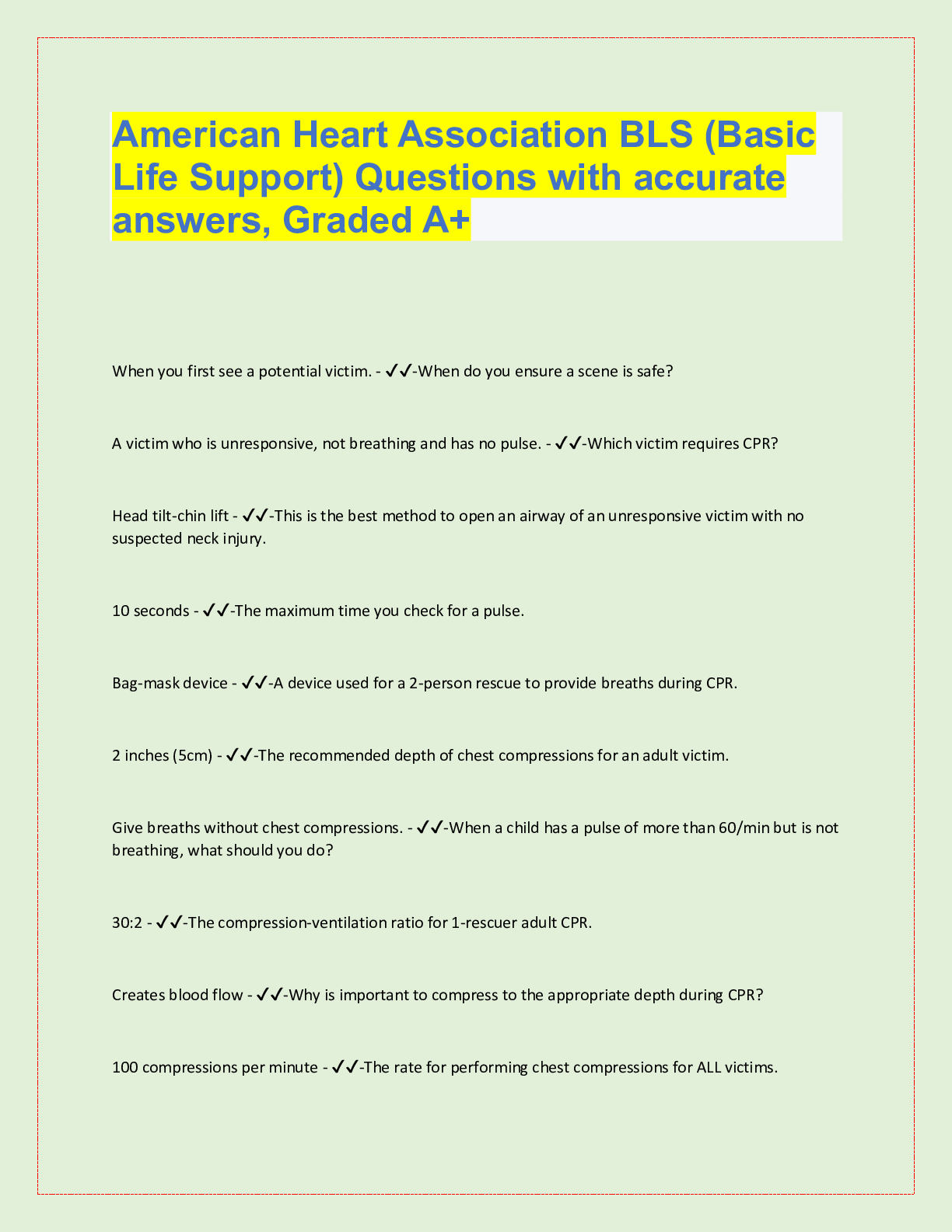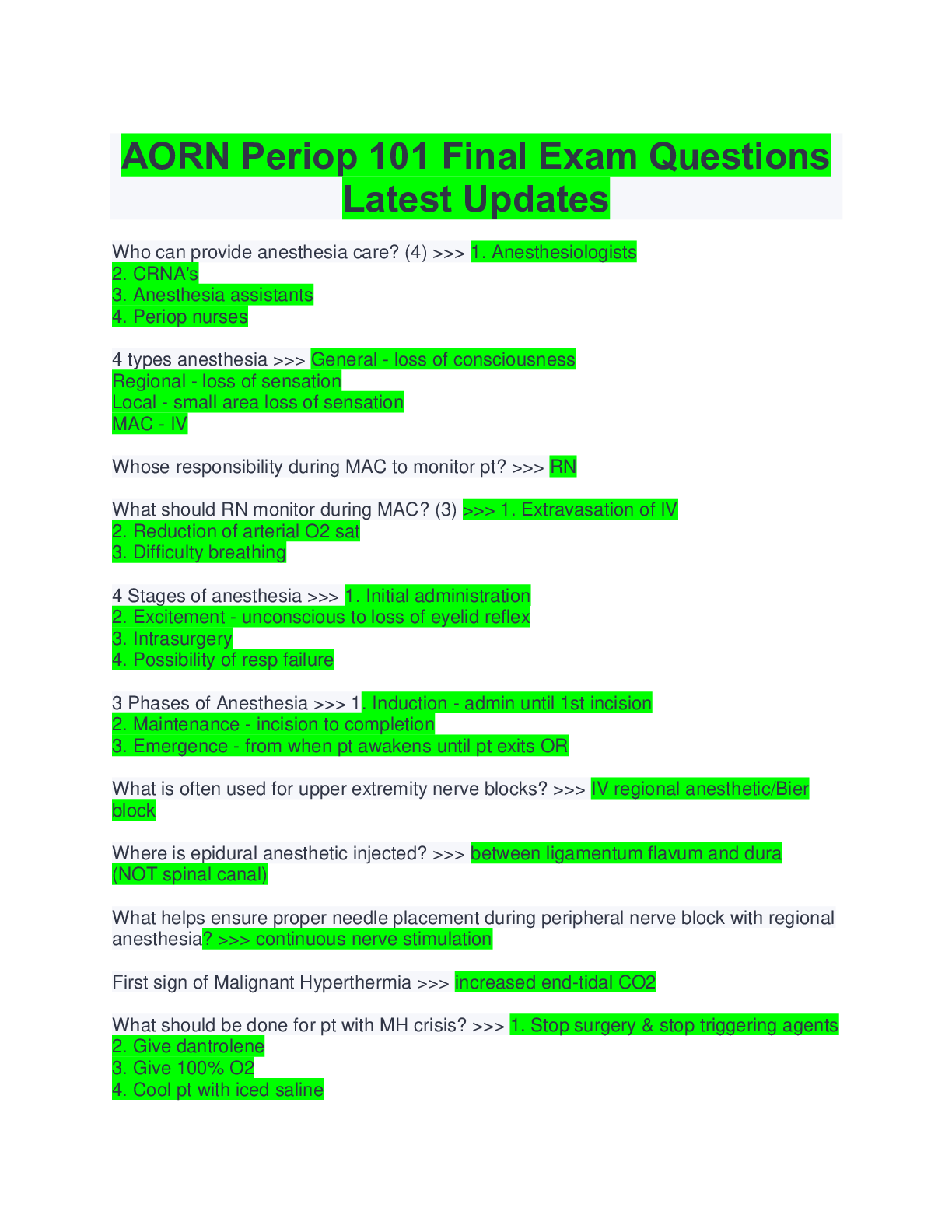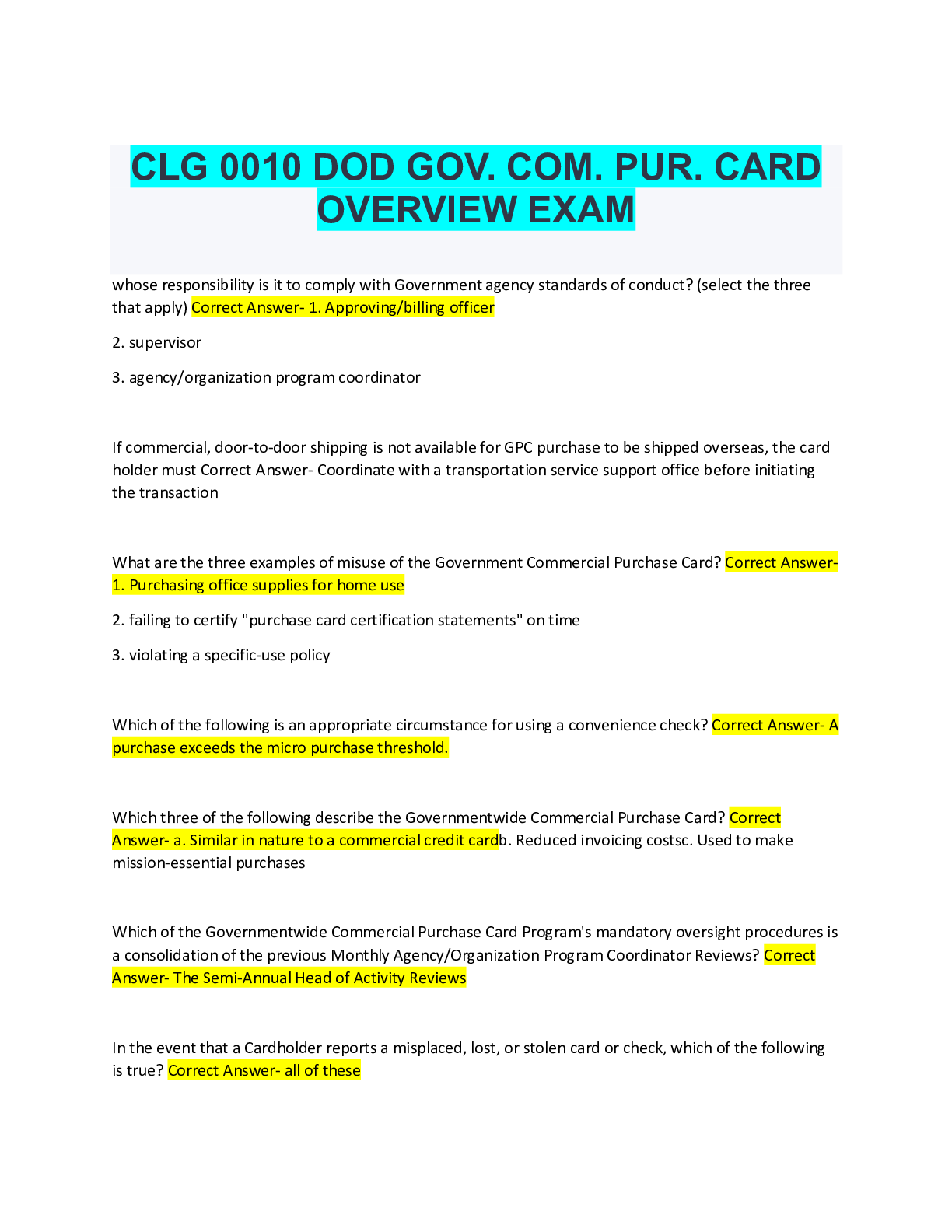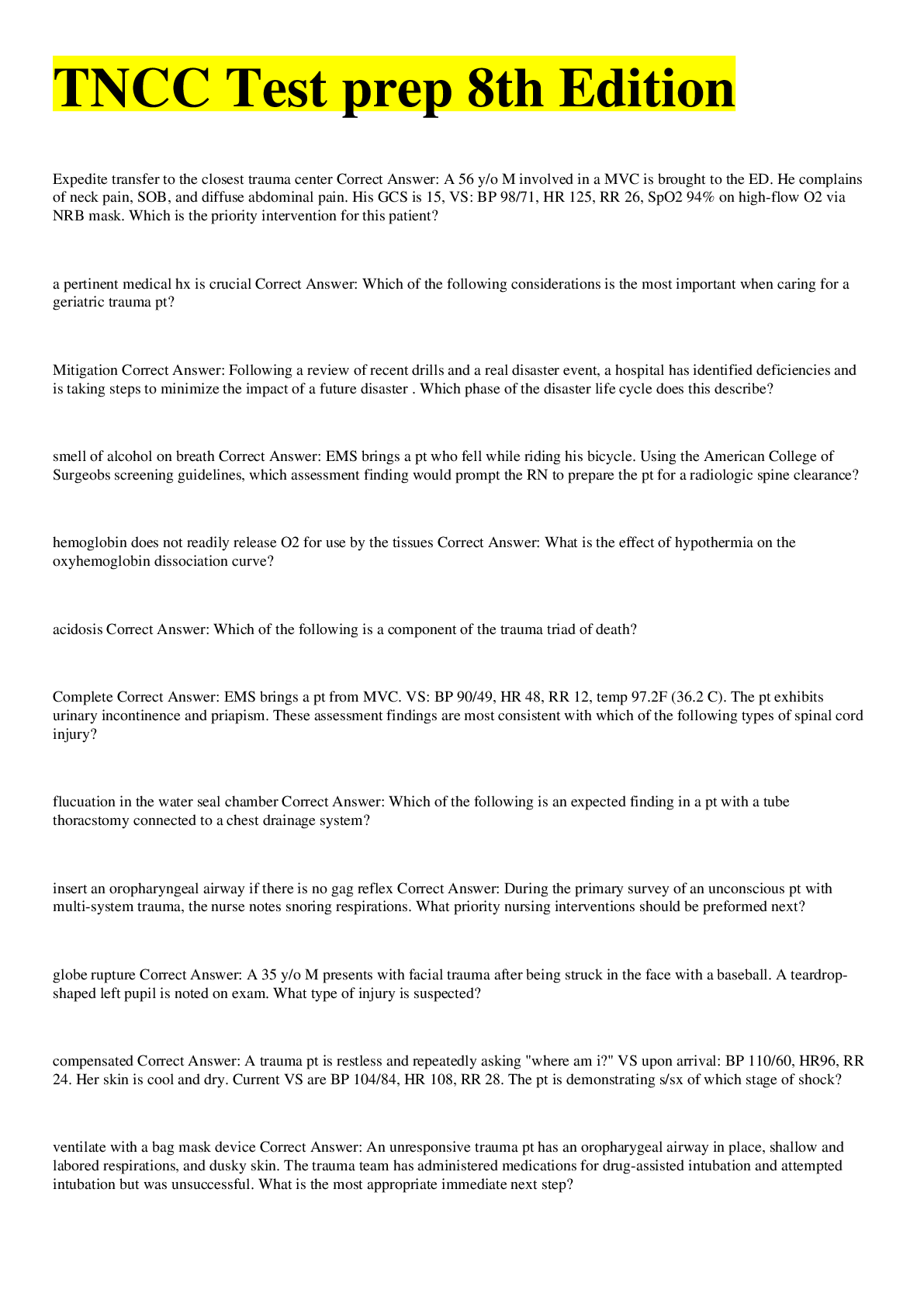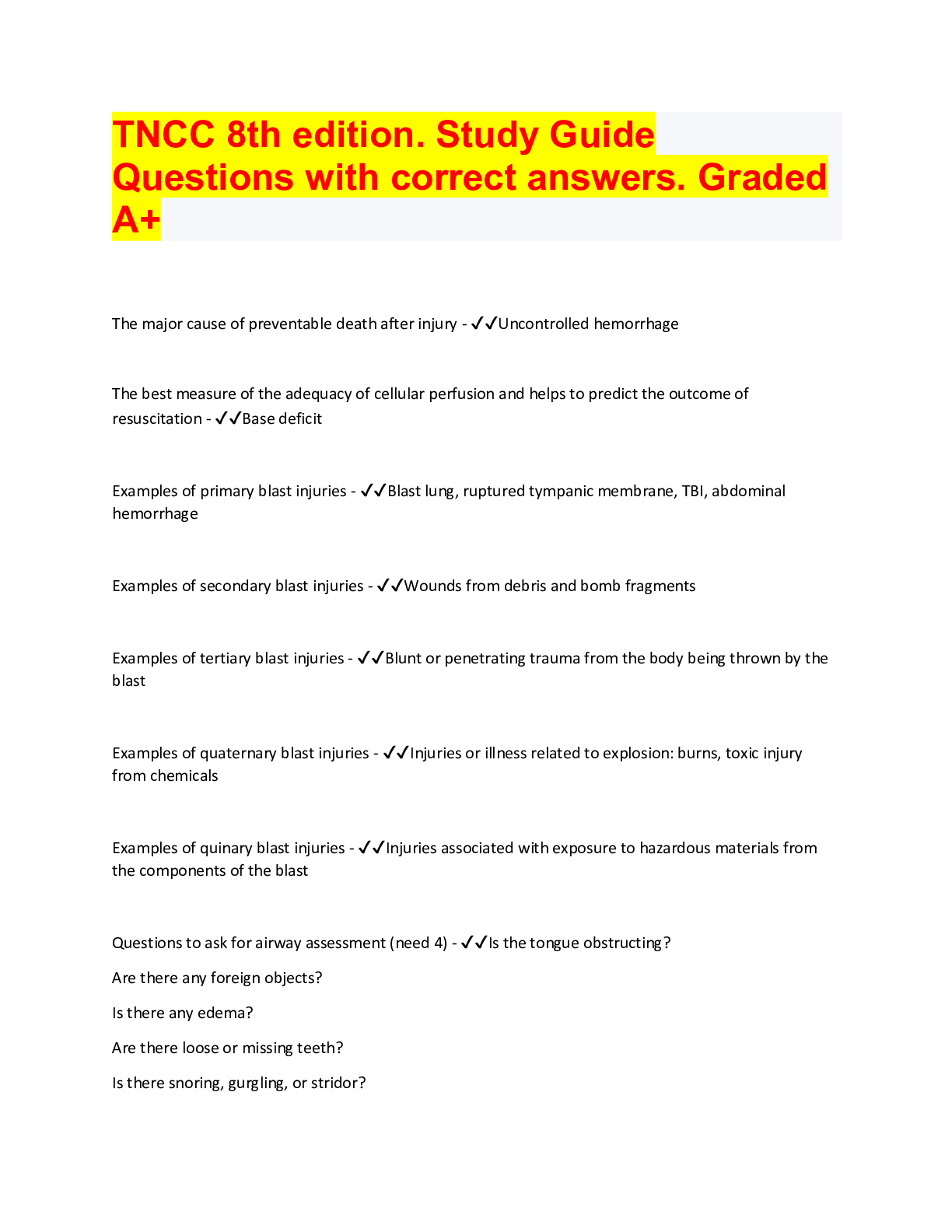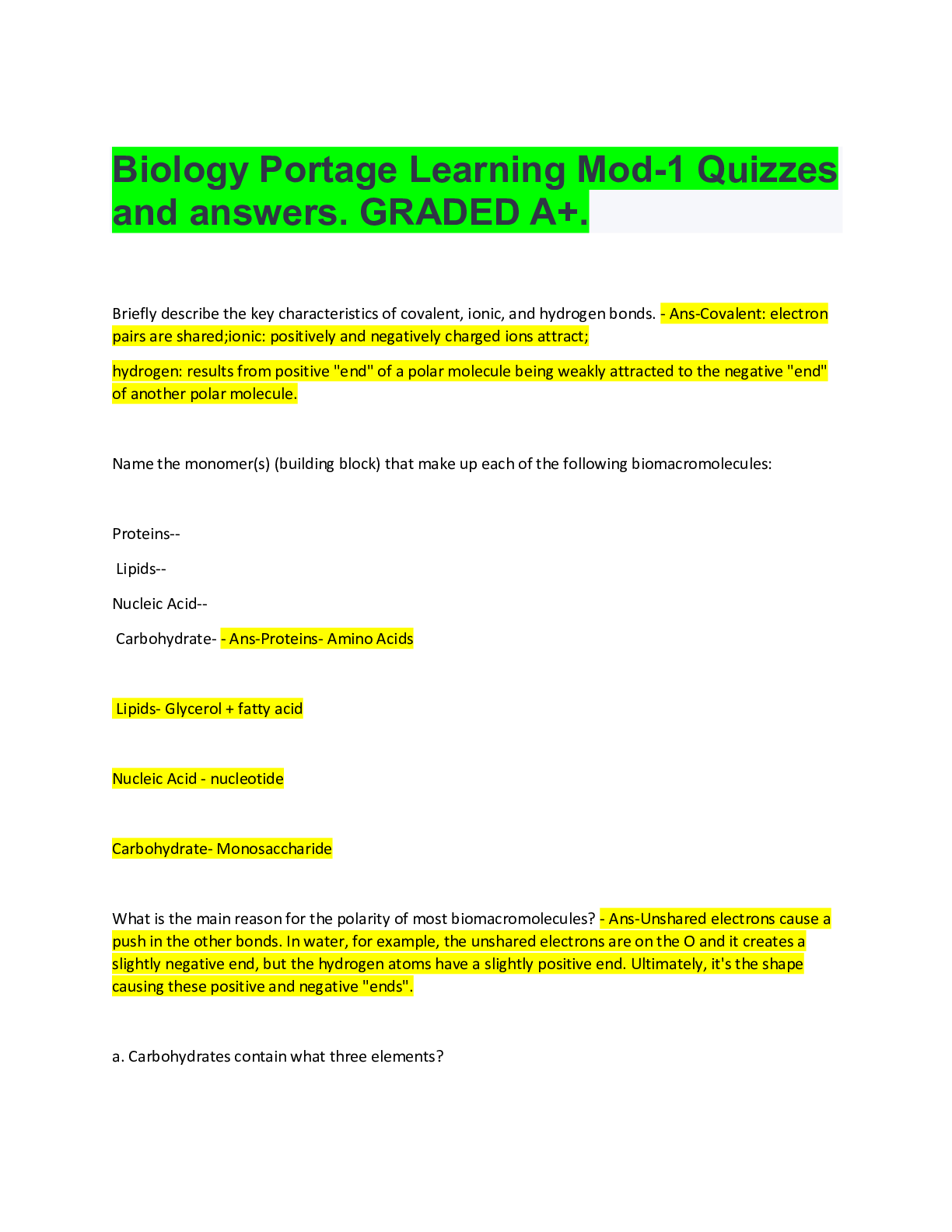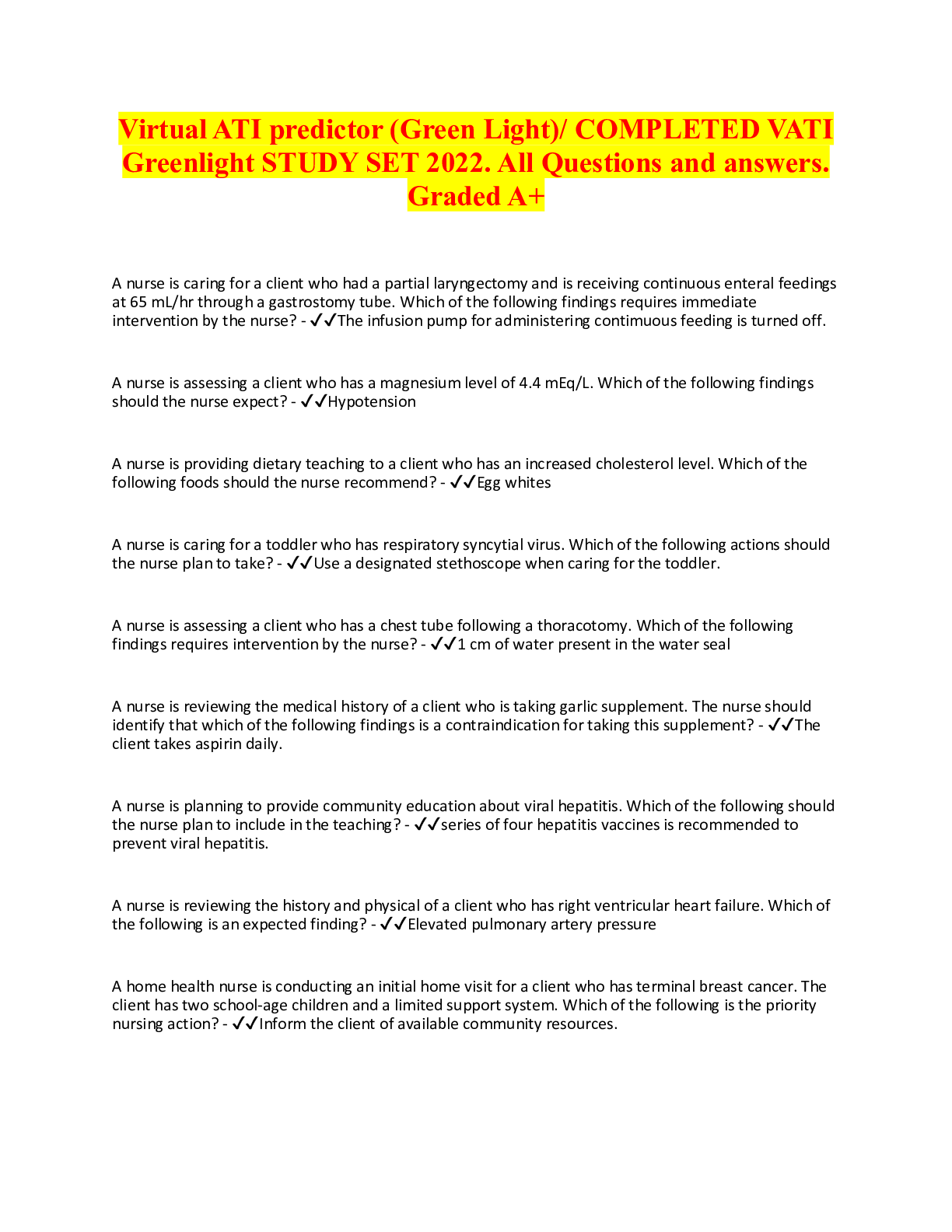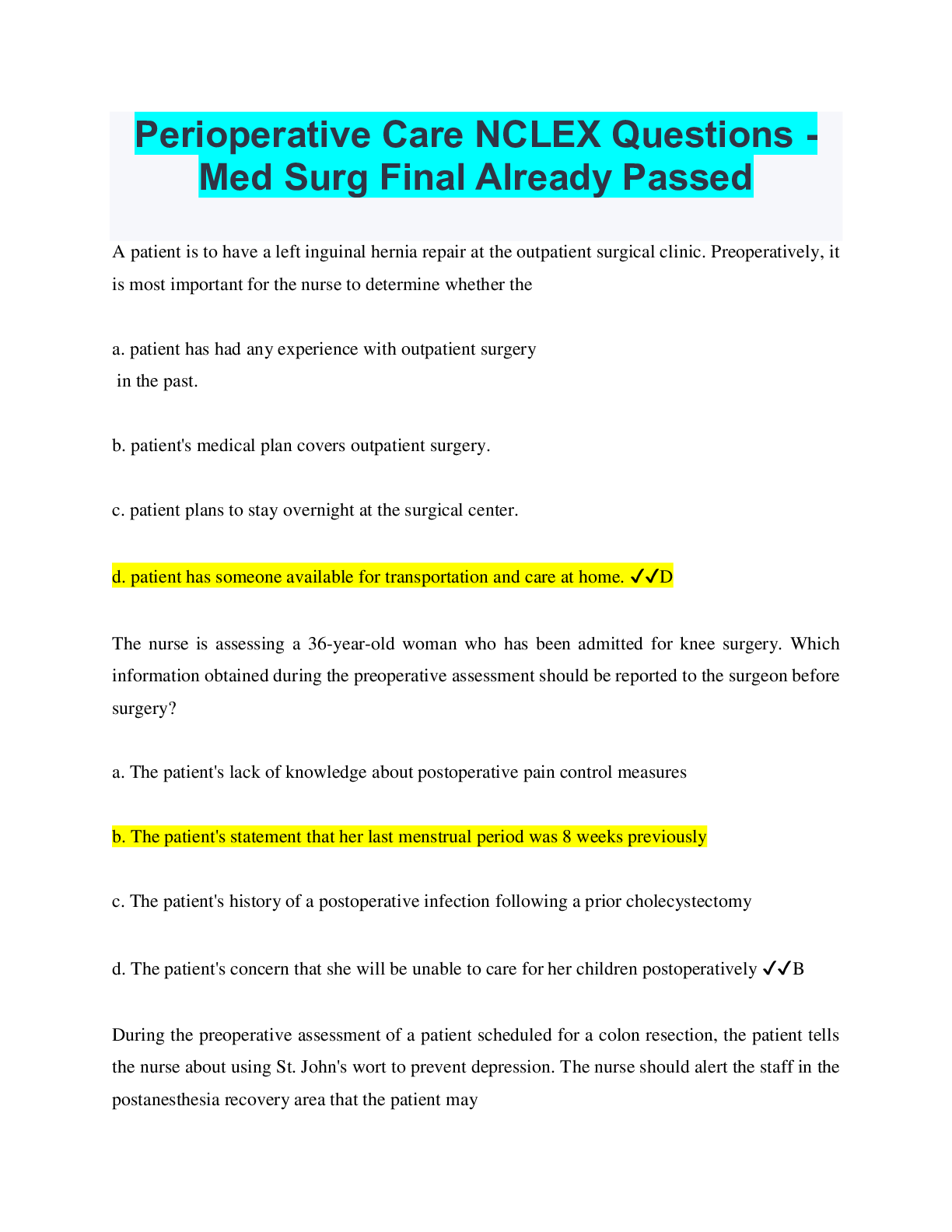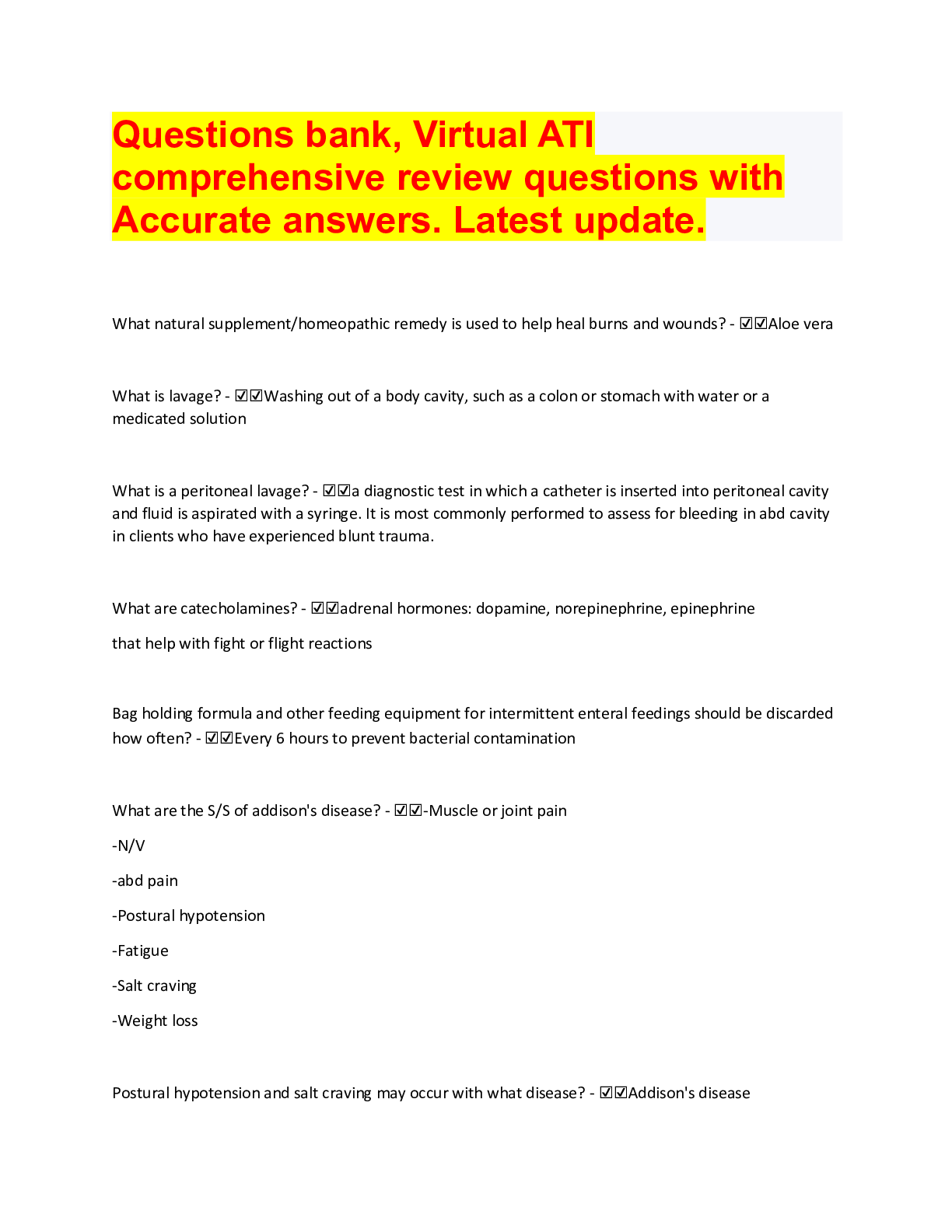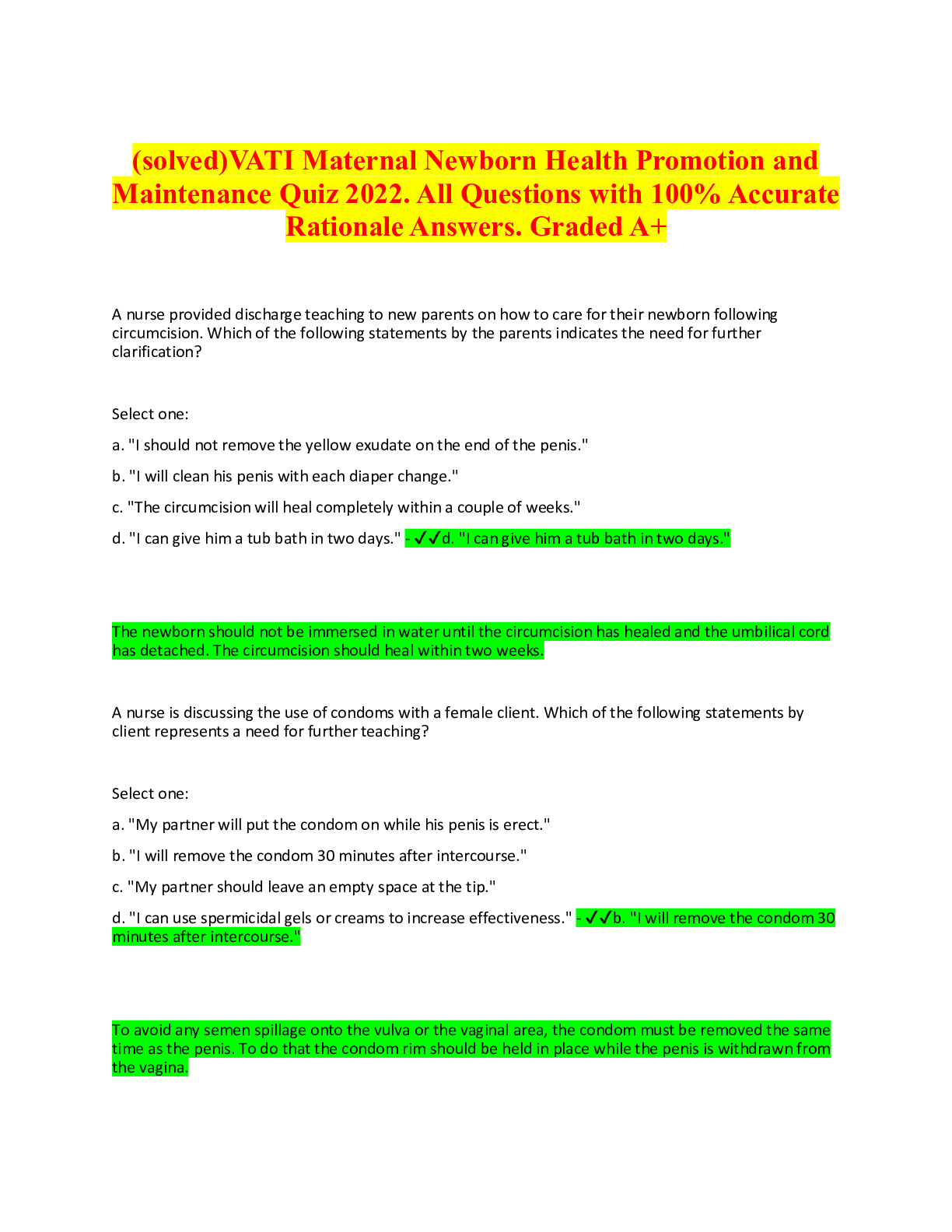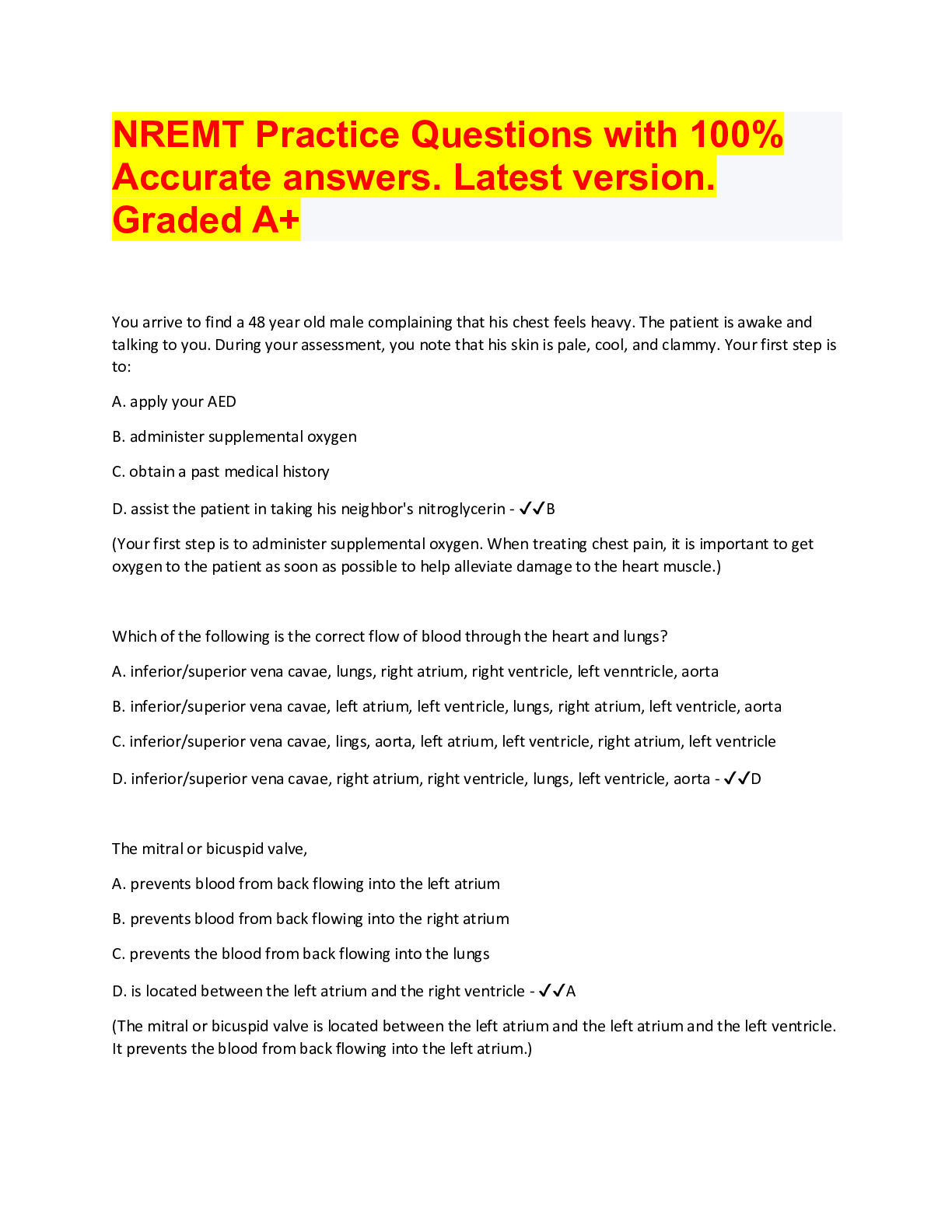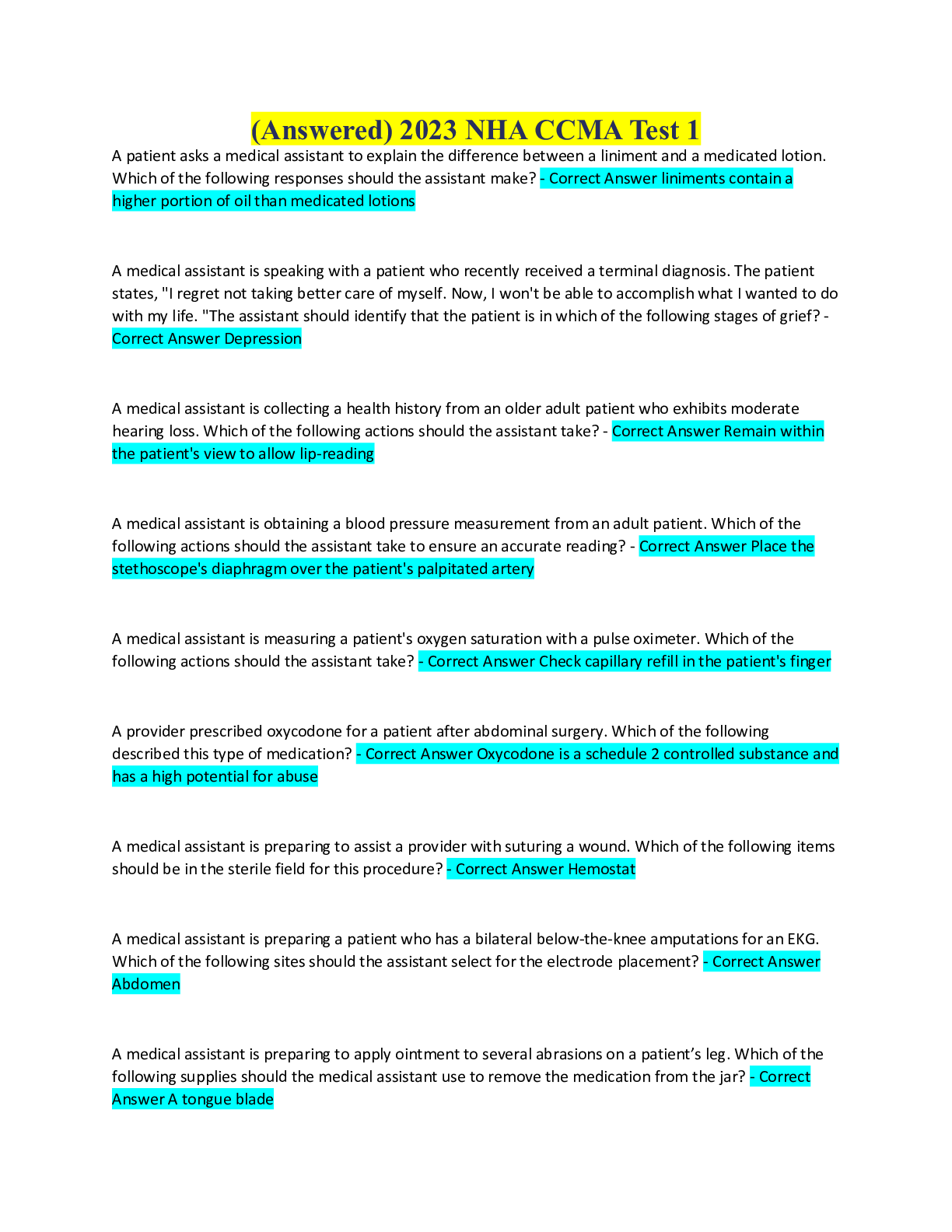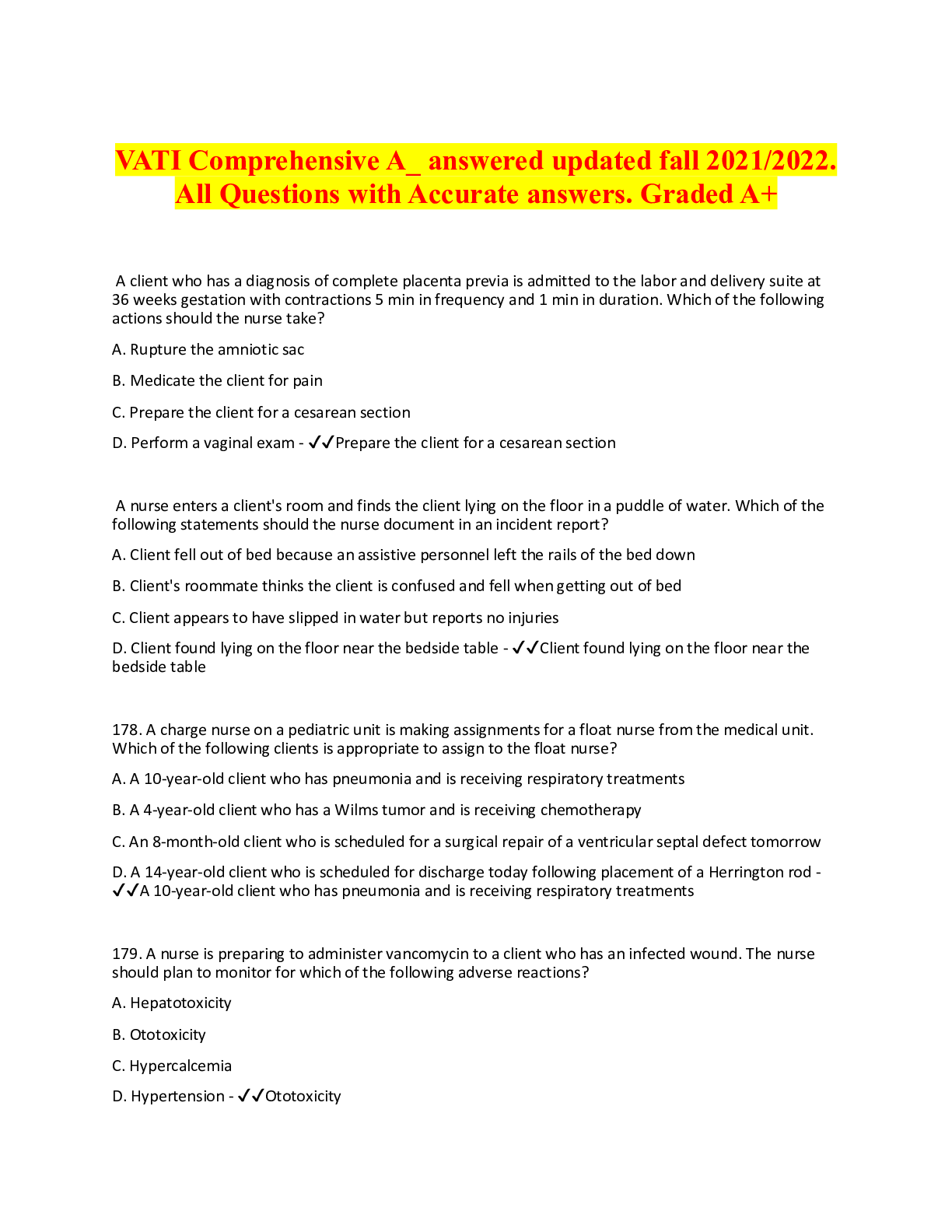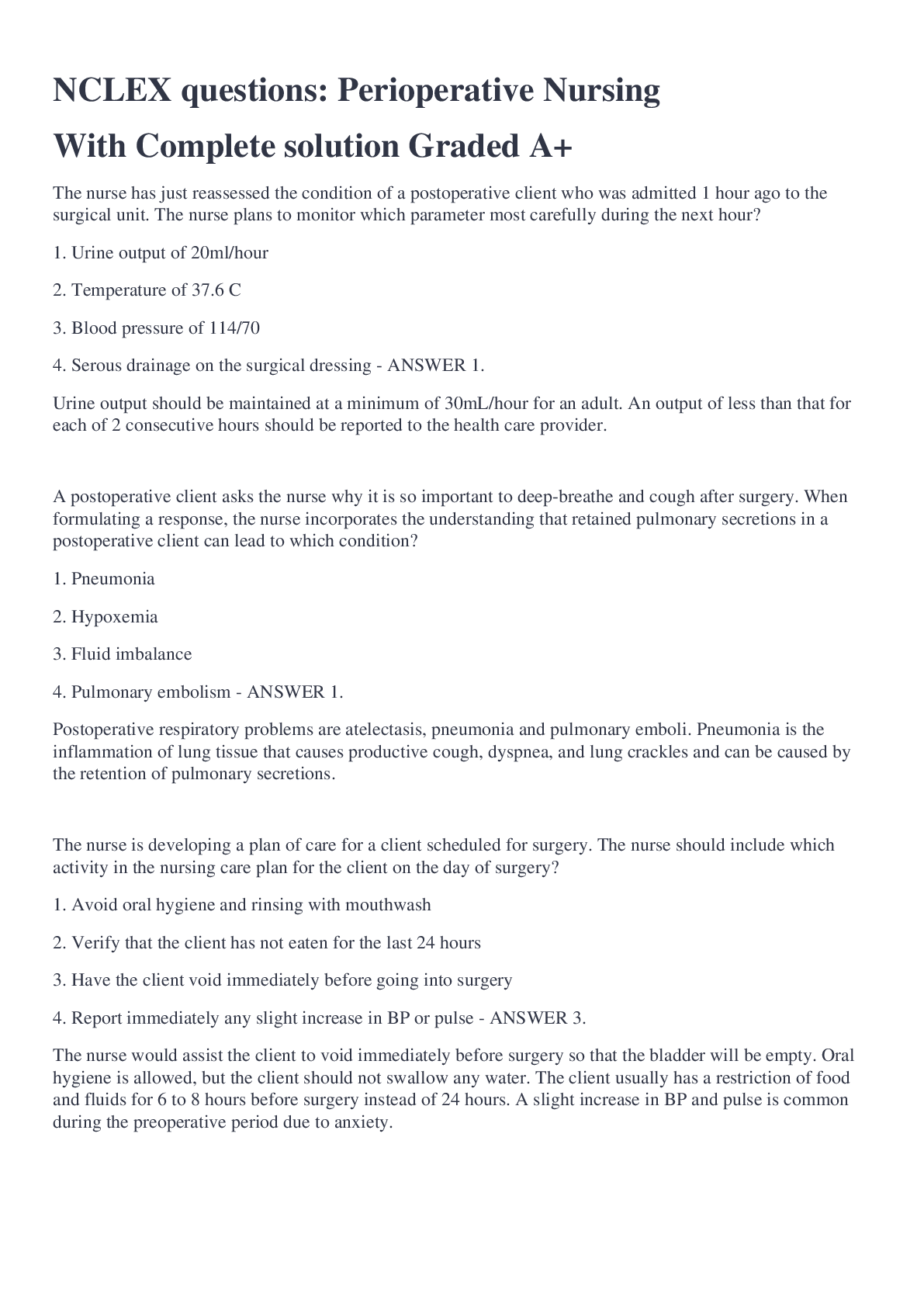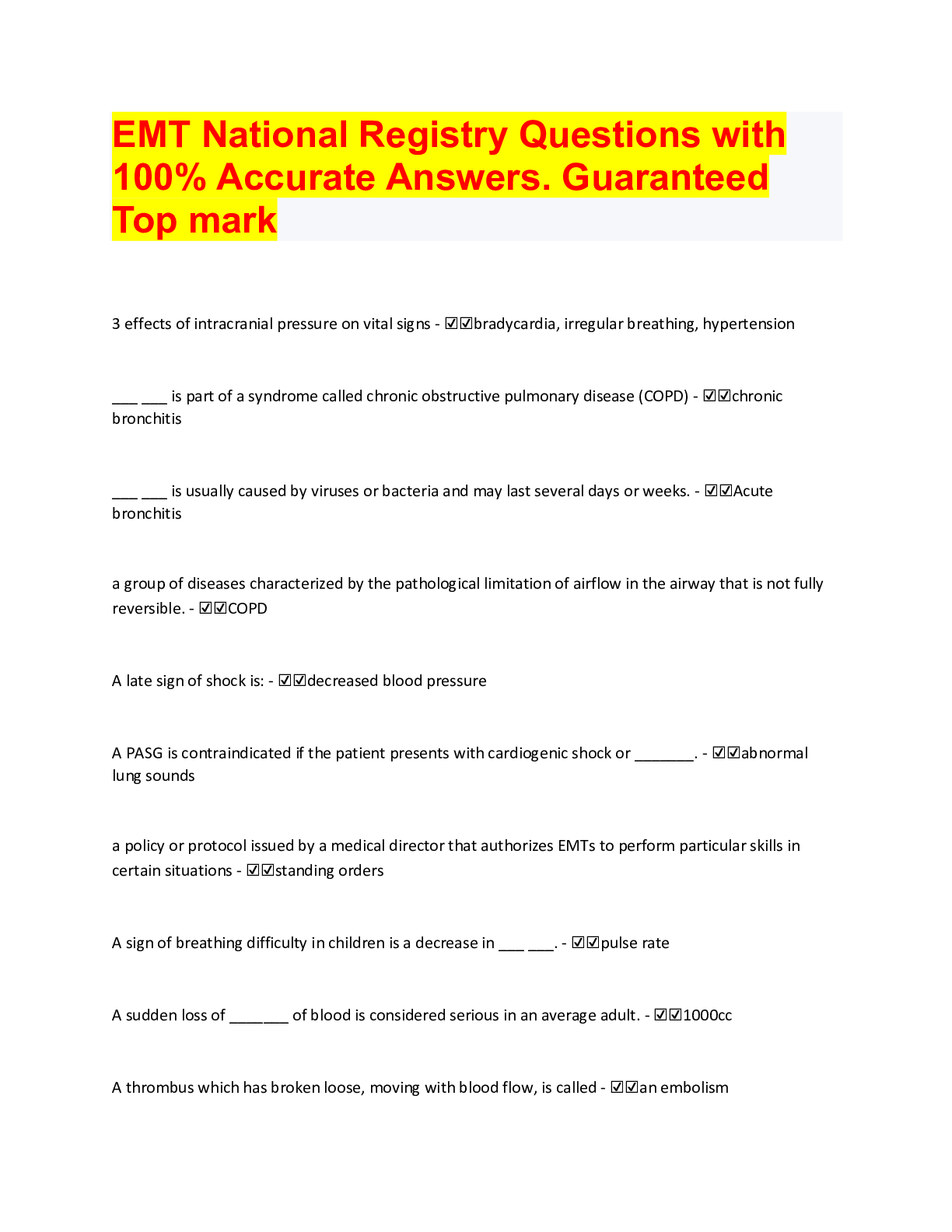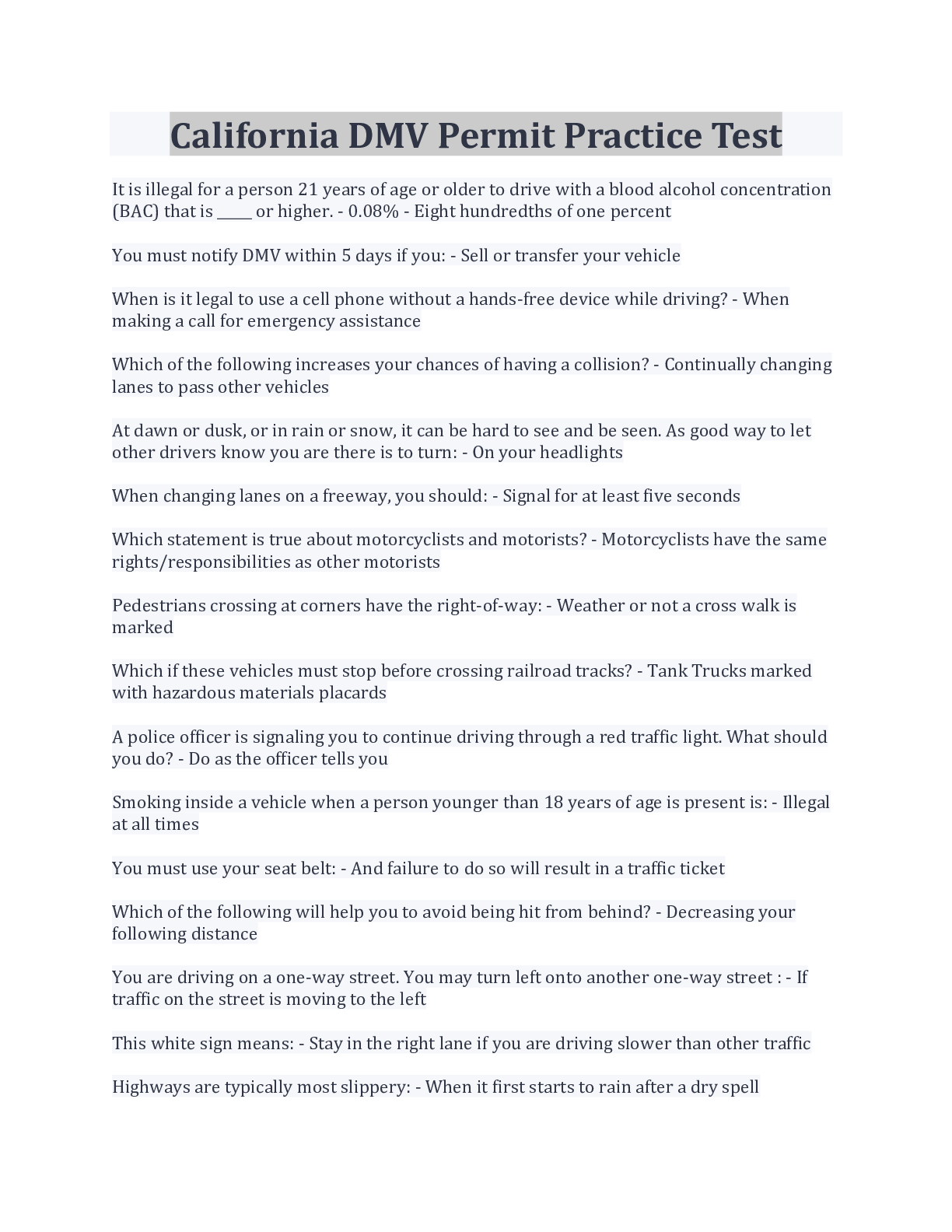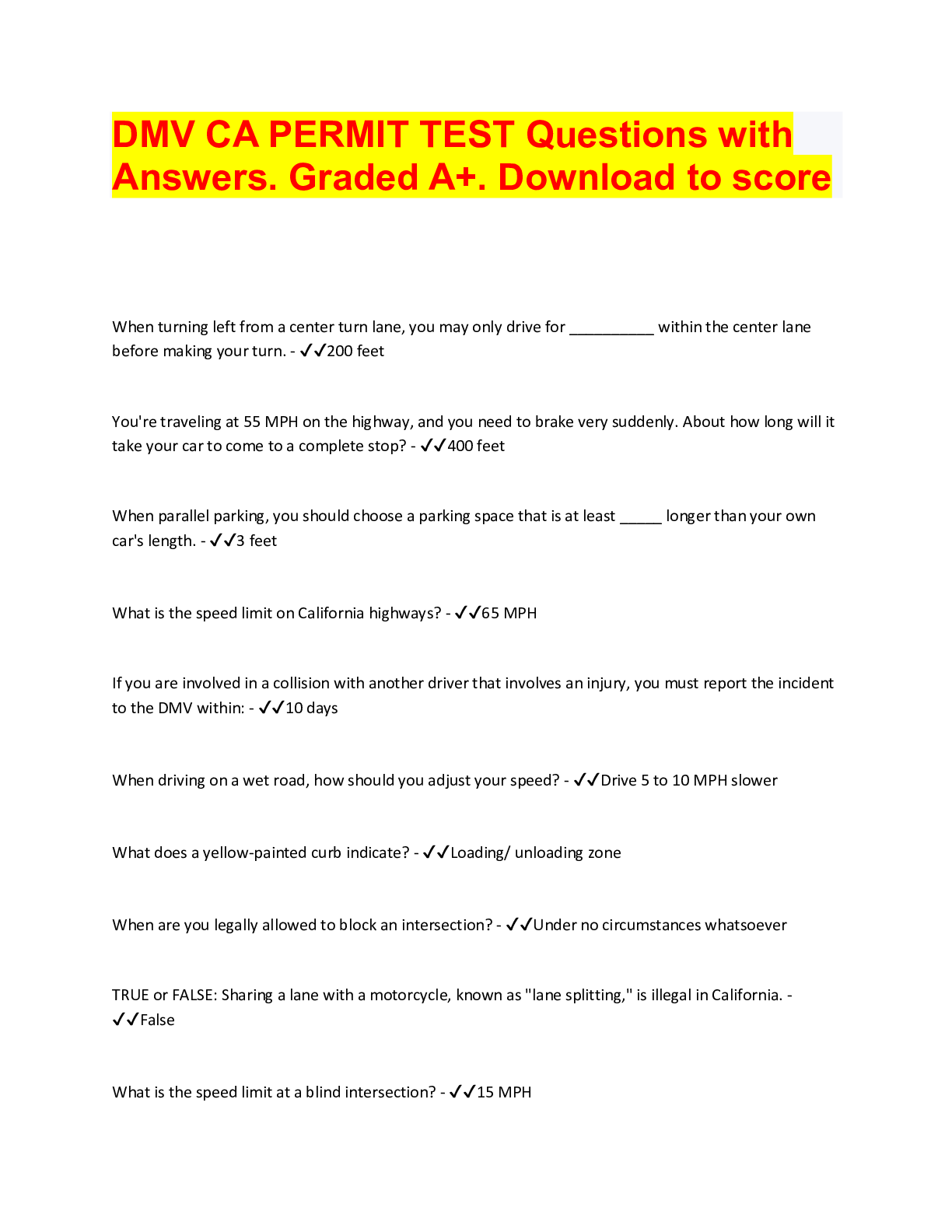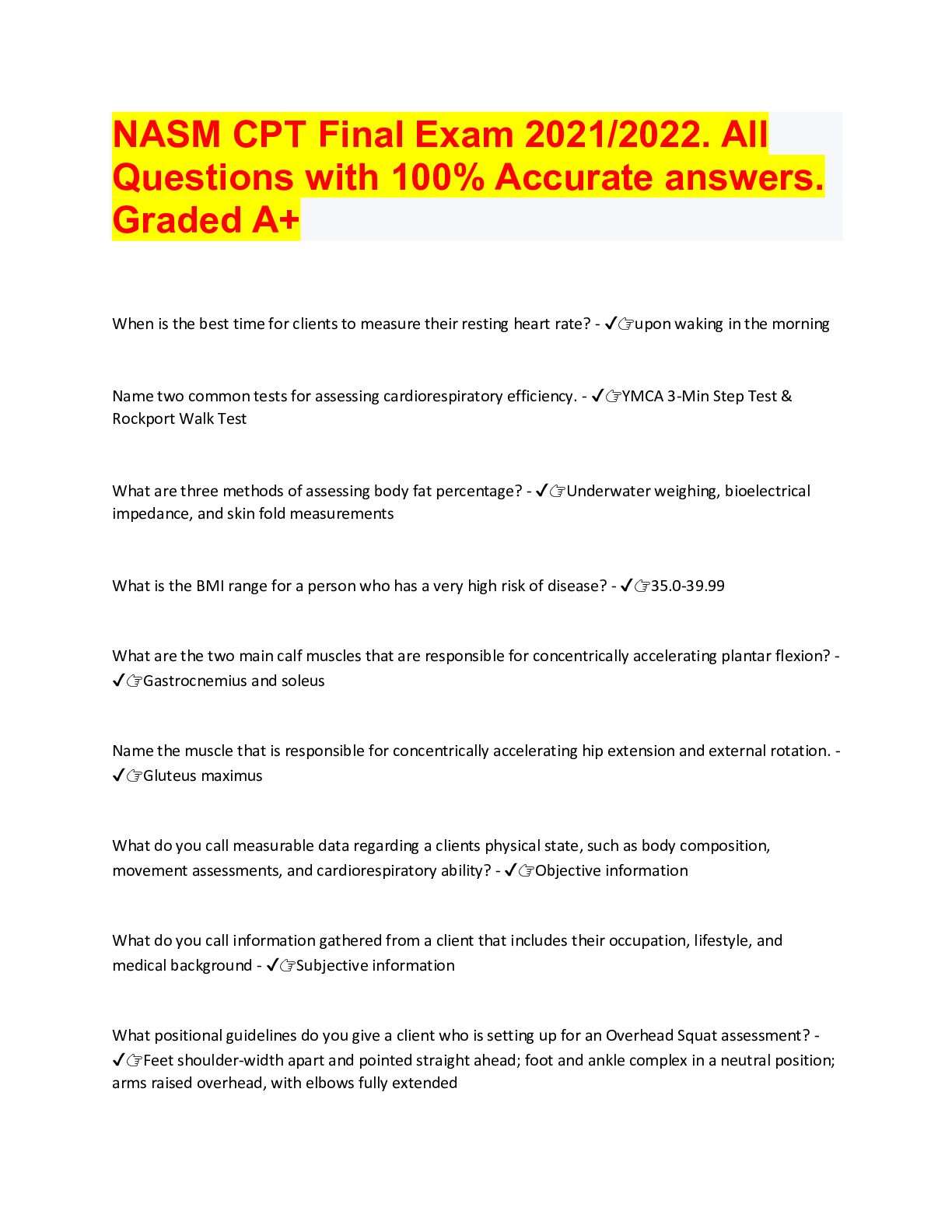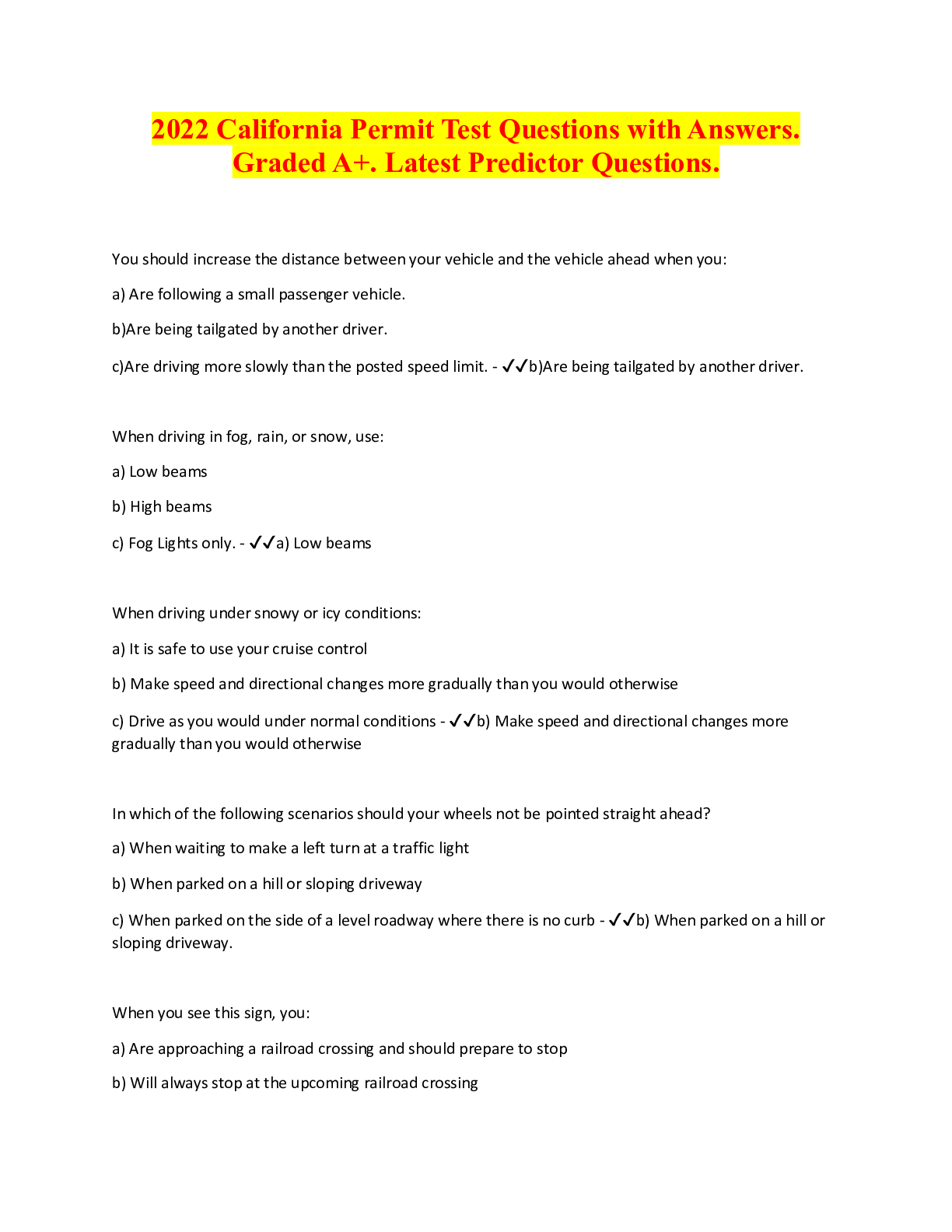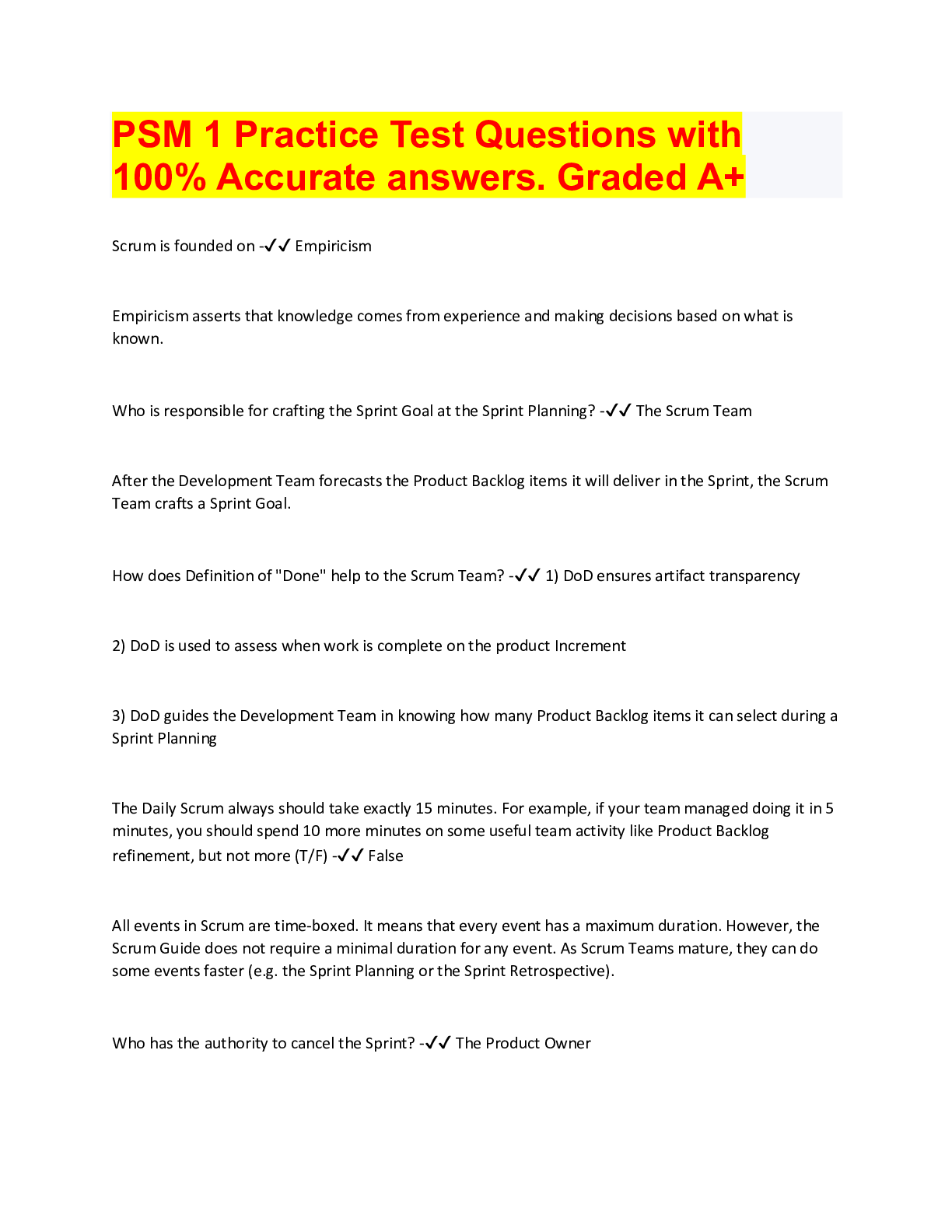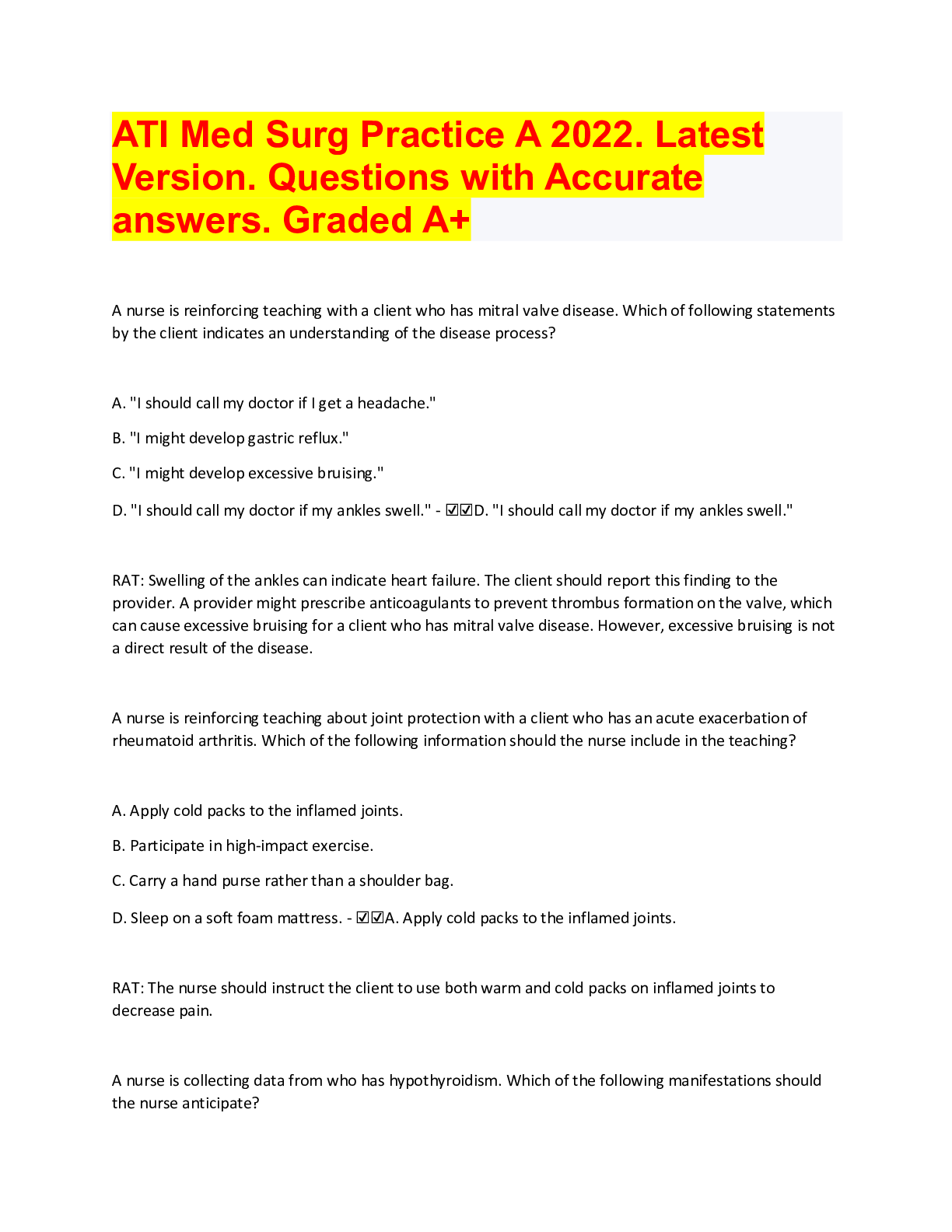*NURSING > QUESTIONS & ANSWERS > Practice Test 1 CCRN (Pass CCRN) ALL QUESTIONS WITH 100% ACCURATE ANSWERS. GRADED A+ (All)
Practice Test 1 CCRN (Pass CCRN) ALL QUESTIONS WITH 100% ACCURATE ANSWERS. GRADED A+
Document Content and Description Below
1. What is vasogenic cerebral edema? - ☑☑Vasogenic cerebral edema is an increase in extracellular fluid caused by a breakdown of the blood-brain barrier with the resultant increase in vascular per... meability. This cerebral edema begins locally and becomes more generalized. Common causes are trauma (including surgical trauma), tumors, hemorrhage, and abscesses 2. What ventilator parameter indicates fluid volume excess? - ☑☑An A:a gradient greater than 10 mm Hg is a reflection of a diffusion defect. Note that the process of diffusion is between A (alveolus) and (a) arterial blood. An increase in intraalveolar fluid dilutes and inactivates surfactant, causing alveolar collapse (decreasing vital capacity) and decreases lung compliance. Peak inspiratory pressure increases reflect a decrease in lung compliance 3. What does autonomy refer to? - ☑☑The patient's right to make decisions for themselves 4. What does beneficence mean? - ☑☑Obligation to do good 5. What does nonmaleficence mean? - ☑☑Obligation to do no harm 6. What does fidelity mean? - ☑☑the obligation to abide by agreements and responsibilities 7. What does veracity mean? - ☑☑The obligation to tell the truth 8. What are Diagnosis-Related groups? - ☑☑DRGs constitute a prospective payment program for Medicare patients. Payment is based on primary and secondary diagnosis, primary and secondary procedures, age, and length of hospitalization 9. BNP is secreted in response to? - ☑☑Ventricular wall stretch 10. What are omnious signs in a patient with status asthmaticus? - ☑☑A normalization or increase in the PaCO2. This patient is still tachypneic, and if ventilation is normal, PaCO2 should be decreased. The other ominous sign in this patient would be absence of wheezing or rhonchi, because they would indicate that ventilation is insufficient to cause these noises. 11. What problems arise from losses from the GI tract? - ☑☑Any loss results in hypokalemia. Vomiting results in loss of acidic contents, whereas losses below the pylorus result is alkalitic losses leading to metabolic acidosis. Fluid is sequestered in the intestine leading to hypovolemia, which could cause hypovolemic shock. 12. Actual problems are worse than potential problems!! - ☑☑ 13. How can you differentiate the cause of jaundice? - ☑☑An increase in direct bilirubin is associated with biliary obstruction because direct bilirubin is conjugated. An increase in indirect bilirubin is associated with hepatic disease or excessive hemolysis because indirect bilirubin is unconjugated 14. What antihypertensive meds work best in African american patients? - ☑☑African-Americans do not respond well to angiotensin-converting enzyme inhibitors (e.g., captopril [Capoten]), but they do respond well to an angiotensin II blocker (valsartan [Diovan]). Of the beta-blockers, labetalol works best. Of the calcium channel blockers, diltiazem works best 15. What lab values define acute respiratory failure? - ☑☑50-50! 16. PaO2<50 and/or PaCO2>50 17. Hyperkalemia can cause what? - ☑☑Diarrhea-increases gastric motility 18. Flaccid paralysis- partially depolarizes muscle cells, prevents further depolarization 19. Every 1 inch increase in abdominal girth equates to how much blood accumulation in the abdomen - ☑☑500-1000mL 20. What pacing method would be used in a patient in atrial fib? - ☑☑VVI- you don't want to sense or pace the atria. 21. 1st letter-paced chamber 22. 2nd letter-chamber sensed 23. What is the difference between an anaphylactic and anaphylactoid reaction? - ☑☑Anaphylactoid reaction is clinically indistinguishable from anaphylactic reaction but does not require previous exposure to the antigen. Anaphylactoid reaction is not IgE mediated, and direct activation and degranulation of mast cells are thought to be triggered by the complement system. Anaphylactic reaction requires previous exposure to the antigen and is IgE mediated 24. Mitral stenosis is associated with what? - ☑☑Pinkish discoloration of the cheeks. It is a diastolic murmur 25. What murmur is associated with widened pulse pressure? - ☑☑Aortic regurg 26. What murmur is associated with narrowed pulse pressure? - ☑☑Mitral regurg 27. What lead changes are associated with left ventricle hyperthrophy? - ☑☑Strain pattern in V5 and V6 (asymmetric T wave inversion) 28. When the depth of the S wave in lead V1 or V2 plus the height of the R wave in lead V5 or V6 is 35 mm or greater, this constitutes voltage 29. What lead changes are associated with right ventricle hypertrophy? - ☑☑strain pattern in V1 and V2. Prominent R wave in V1 reverse progression of the R wave across the precordium. 30. What organ system is the most common to fail in severe sepsis? - ☑☑Hematologic- coagulopathies are common in severe sepsis 31. What are the early signs of hypoglycemia? - ☑☑The early signs of hypoglycemia are mediated by the sympathetic nervous system, which acts to mobilize glucose stores (tachycardia, tachypnea, diaphoresis). Later signs of hypoglycemia are related to low glucose levels in the brain (neuroglycopenia) 32. **Early signs can be masked in pts taking beta-blockers 33. What is the systolic BP at different locations if you are able to palpate a pulse? - ☑☑If the radial artery can be palpated, the systolic BP is at least 80 mm Hg. If the brachial artery can be palpated, the systolic BP is at least 70 mm Hg. If only the carotid artery can be palpated, the systolic BP is approximately 60 mm Hg 34. What happens to SvO2 if oxygen delivery decreases for any reason - ☑☑SvO2 is a reflection of oxygen reserve. If oxygen delivery is decreased, oxygen consumption continues, and oxygen reserve decreases. SvO2 decreases any time the delivery of oxygen decreases or the consumption of the tissues increases 35. A simple way to estimate CVP is to add 5 cm to the measured height that the jugular veins are distended above the sternal angle (angle of Louis) with the patient in a 45-degree angle - ☑☑ 36. What is the most common cause of right ventricular failure? - ☑☑Left ventricular failure- causes pulmonary congestion and pulmonary HTN which increases the workload for the right side of the heart 37. Other causes- primary pulmonary hypertension, RV infarction, pulmonic stenosis, PE, mitral stenosis 38. What findings would be consistent with a massive hemothorax? - ☑☑Fluid, such as blood, will be dull to flat to percussion. The blood in the pleural space compresses normal lung tissue and causes diminished to absent breath sounds. A large volume of blood in the pleural space may cause the trachea to shift away from the affected side toward the unaffected side [Show More]
Last updated: 1 year ago
Preview 1 out of 15 pages

Reviews( 0 )
Document information
Connected school, study & course
About the document
Uploaded On
Aug 11, 2022
Number of pages
15
Written in
Additional information
This document has been written for:
Uploaded
Aug 11, 2022
Downloads
0
Views
65



